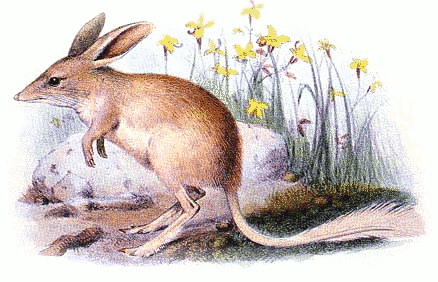|
| 질의: marsupial | 결과: 201번째/223 | |
Bilby (Family: Thylacomyidae, Genus: Macrotis) - Wiki
| 제목: | Bilby (Family: Thylacomyidae, Genus: Macrotis) - Wiki
| |

| 해상도: 438x282
파일크기: 64245 Bytes
촬영일: 2007:09:16 01:23:04
등록시간: 2007:09:16 01:26:34
|
Bilby (Family: Thylacomyidae, Genus: Macrotis) - Wiki
Bilby
From Wikipedia, the free encyclopedia
[Photo] Illustration of Lesser Bilby (Macrotis leucura). Source: WPClipart http://www.wpclipart.com/animals/B/
Bilbies are marsupial omnivores; they are members of the Peramelemorphia biological order and the largest of the bandicoots. Before European colonisation of Australia there were two species. One became extinct in the 1950s, the other survives but remains endangered.
The term bilby is a loan word from the Yuwaalaraay Aboriginal language of northern New South Wales, meaning long-nosed rat. It is known as dalgite in Western Australia and the nickname pinkie is sometimes used South Australia. The Wiradjuri of New South Wales also call it bilby.
Bilbies have the characteristic long bandicoot muzzle and very long ears. As compared with other bandicoots, they have a longer tail, bigger ears, and softer, silky fur. They are nocturnal omnivores that do not need to drink water, as they get all the moisture they need from their food, which includes insects and their larvae, seeds, spiders, bulbs, fruit, fungi and very small animals. Most food is found by digging or scratching in the soil, and using their very long tongues.
They are excellent burrowers and build extensive tunnel systems with their strong forelimbs and well-developed claws. A bilby typically makes a number of burrows within its home range, up to about a dozen, and moves between them, using them for shelter both from predators and the heat of the day. To prevent her pouch from getting filled with dirt while she is digging, the female Bilby's pouch faces backwards.
There have been reasonably successful moves to popularise the bilby as a native alternative to the Easter Bunny by selling chocolate Easter Bilbies (sometimes with a portion of the profits going to Bilby protection and research). Reintroduction efforts have also begun, with a successful reintroduction into the Arid Recovery Reserve in South Australia in 2000, and plans underway for a reintroduction into Currawinya National Park in Queensland, with a recent success with 6 bilbies released into the feral-free sanctuary in early February 2006.
Successful reintroductions have also occurred onto Peron Peninsula in Western Australia as a part of an initiative of the Western Australian Department of Environment and Conservation as a part of Western Shield. Successful re-introductions have also occurred on other conservation lands, also including islands, and the Australian Wildlife Conservancy Scotia Sanctuary and Yookamurra Sanctuaries. There is a highly successful bilby breeding program at Kanyana Wildlife Rehabilitation Centre, near Perth, Western Australia.
The placement of the bilbies within the Peramelemorphia has changed in recent years. Vaughan (1978) and Groves and Flannery (1990) both placed this family within the Peramelidae family. Kirsch et al. (1997) found them to be distinct from the species in Peroryctidae (which is now a subfamily in Peramelidae). McKenna and Bell (1997) also placed it in Peramelidae, but as the sister of Chaeropus in the subfamily Chaeropodinae.
Species
Genus Macrotis
Greater Bilby, Macrotis lagotis
Lesser Bilby, Macrotis leucura
http://en.wikipedia.org/wiki/Bilby
| The text in this page is based on the copyrighted Wikipedia article shown in above URL. It is used under the GNU Free Documentation License. You may redistribute it, verbatim or modified, providing that you comply with the terms of the GFDL. |
|
^o^
동물그림창고 똑똑전화 누리집
^o^
|
|